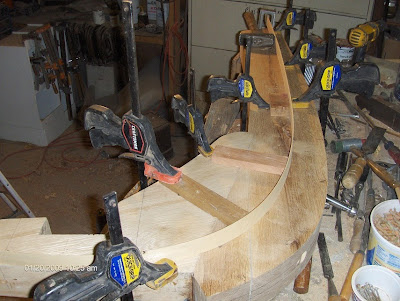I know, this blog about the Ginger is getting to be a bit long but it
did take 6 months of work to finish the boat and a few of you might enjoying
reading about how it was done. For the rest of you… well, it’s going to be
about another 5+/- posting about the rebuild before I go back to other
mundane stuff so hang in there.
Now that the front and the back end of Ginger was replaced I
could start on the planks. I must tell ya’ll that this was a despicable job.
Dirty, filthy old paint on the outside and black Yuck on the inside. All of
this had to be scraped off before I could start in on repairing the planks. I
already had the first 4 planks off and so I started on them. All of the old
screw holes had to be plugged and many of the planks had cracks or large checks(checks are the natural splitting
that occurs in wood) in them that had to be router out and inserts glued into
place.
 |
| Every old screw hole had to be pluged. |
 |
| Then the cracks and the checks had to be routered and filled. |
It was a long and tedious job. When they were repaired and ready to go
on again I beveled a new edge on each one as I set them into place. It took all
of my clamps to install the first few planks. After that, I had to make “rib clamps” to do
the rest.
 |
| Finally, the first couple of planks were installed. They look good, the wood is repaired and the seams tight again. |
A rib clamp squeezes around a rib and provides a place to lightly set
in wedges that hold planks in place while you screw them down.
 |
| I made a dozen of these and they worked out very well. |
 |
| As I moved away from the keel, I had to have a way to hold the planks against each other. These clamps and soft wood wedges could push and hold the planks against their neighbors while I drilled and screwed the plank down. |
After the
first four planks were back on the boat, I started on the planks at the turn of
the hull. This area is where all of the broken ribs occurred. To strengthen and
repair this area first I had to make up short, sister ribs that would ride
between the old ribs to strengthen the hull in this area. To make them I steam bent
short oak rib pieces and bent them to the curve of the hull. It took about 1 hour to
completely steam a rib and then (in about 30 sec)I would pop them out of the
steam box and clamp them into place. The entire center section of the boat had
to have sister ribs installed.
 |
| These sister ribs had just come out of the steam box and are bent against the hull of the boat as they cool and assume their new shape. |
 |
| The starboard side sister ribs are ready to be screwed into place as soon as the planks in this area are finished and installed. |
 |
| At the same time I began to reatatch the repaired forward planks to the new front stem. |
I kept installing the rest of the planks until I
reached the water line where the planking was in good shape. The final plank
came up short of it’s neighbor (because of cleaning up the plank edges and
pushing the planks back together again) and I had to add a long strip to its
edge to make up this difference. After the glue was set, I carefully wedged the
final plank into place and screwed it down. Ginger was now a boat again!
 |
| 1-1/2 inch gap to fill |
 |
| Glueing the plank edge onto the old plank. |
 |
| The last day of planking, installing the "wiskey" plank (called that because you open the wiskey bottle after it is fastened!) |
 |
| Tired but happy. |
 |
| How the shop looked afterwards. |
Now, on to
the rest of the rebuild.
























































